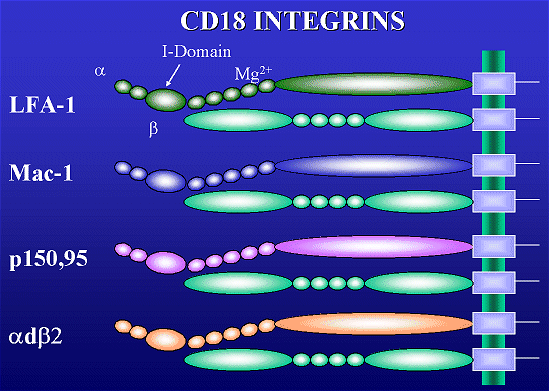Integrins

Integrins are a large family of heterodimeric transmembrane glycoproteins
that attach cells to extracellular matrix proteins of the basement membrane
or to ligands on other cells. Integrins contain large (α)
and small (β) subunits of sizes 120-170 kDa
and 90-100 kDa, respectively. Some integrins mediate direct cell to cell
recognition and interactions. Integrins contain binding sites for divalent
cations Mg2+ and Ca2+, which are necessary for their
adhesive function. Mammalian integrins form several subfamilies sharing
common β subunits that associate with different
α subunits.
β2 integrins are exclusively expressed on leukocytes and
undergo a conformational change encompassing the phosphorylation of the
β subunit upon activation. However, this phosphorylation is neither
necessary nor sufficient for conformational activation. Theactivation
status is controlled by the GFFKR site immediately adjacent to the transmembrane
domain of the alpha chain. A structural model of a β2 integrin (Harris
et al. 2000) is suggested by site-directed mutagenesis and truncation
mutants (link to Harris, E.S., McIntyre, T.M., Prescott, S.M., and Zimmerman,
G.A. The leukocyte integrins. J.Biol.Chem. 275(31):23409-23412, 2000)
β2 integrins include 4 different heterodimers CD11a/CD18
[Lymphocyte Function-Associated Antigen-1] (LFA-1)
the predominant β2 integrin, CD11b/CD18 (Mac-1)
exclusive to granulocytes and monocytes, CD11c/CD18 (p150,95),
and CD11d/CD18. A mutation in the gene encoding the β2
(CD18) molecule results in a genetic disorder, LAD, Leukocyte Adhesion
Deficiency. LAD patients have recurrent bacterial infections due
to the inability to effectively recruit granulocytes in response to infections.
The most important member of the β1 integrin subfamily on leukocytes is Very Late Antigen-4 (VLA-4, CD49d/CD29, α4 β1). VLA-4 binds to its ligand VCAM-1, and is chiefly responsible for lymphocyte adhesion to vascular endothelium and leukocyte recruitment to the inflamed area.
Click here for a graphical Structure of Integrins and diagrams concerning integrin activation.
Comment on this page's content or view comments made by others!